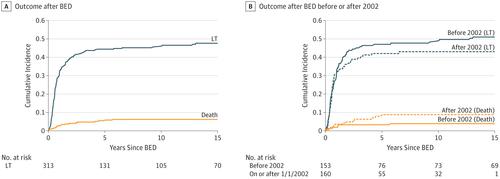JAMA Surgery ( IF 15.7 ) Pub Date : 2019-01-01 , DOI: 10.1001/jamasurg.2018.3180 Elyse LeeVan 1 , Lea Matsuoka 2 , Shu Cao 3 , Susan Groshen 3 , Sophoclis Alexopoulos 2

|
Importance Some infants with biliary atresia are treated with primary liver transplant (pLT), but most are initially treated with biliary-enteric drainage (BED) with a subsequent salvage liver transplant. Given the improvements in liver transplant outcomes, it is important to determine whether BED treatment remains the optimal surgical algorithm for patients with biliary atresia.
Objective To compare the survival of patients with biliary atresia initially treated with BED with patients who underwent pLT.
Design, Setting, and Participants This cohort study used deidentified records from the California Office of Statewide Health Planning and Development database to identify patients with biliary atresia (n = 1252) between January 1, 1990, through December 31, 2015. Patients were categorized into 1 of 2 cohorts: those who received BED treatment and those who underwent pLT. Excluded from the study were those born before January 1, 1995, and those without any documented operative intervention by age 5 years. Data analysis was performed from January 1, 1990, to December 31, 2015.
Main Outcomes and Measures Overall survival was compared between the BED and pLT cohorts using the Kaplan-Meier method. The treatment’s association with treatment era was examined by comparing survival before 2002 and on or after January 1, 2002.
Results In total, 1252 patients with biliary atresia were identified. After exclusions, 626 remained; of these patients, 351 (56.1%) were female and 275 (43.9%) were male with a median (interquartile range) age at intervention for initial BED treatment of 65 (48-81) days. Among the 626 patients studied, initial BED treatment was performed in 313 patients (50.0%), and pLT was performed in 313 patients (50.0%). Although patients who underwent pLT had a higher mortality rate within the first 3 months after the procedure, they had a reduced risk of long-term mortality compared with patients initially managed with BED treatment (hazard ratio [HR] ≥6 months after the initial procedure, 0.19; 95% CI, 0.08-0.42; P = .01). Patients requiring salvage liver transplant had a substantially higher risk of mortality than patients who received pLT (HR, 0.43; 95% CI 0.25-0.76; P = .003). Those who underwent pLT had superior survival compared with BED treatment recipients on or after 2002 (HR, 0.16; 95% CI, 0.05-0.54; P < .001), and that persisted when censoring patients who underwent salvage liver transplant (HR, 0.23; 95% CI, 0.07-0.82; P = .01).
Conclusions and Relevance Patients who underwent pLT experienced superior long-term survival compared with patients who underwent BED treatment. Multi-institutional trials are needed to determine which initial treatment is most advantageous to patients with biliary atresia.
中文翻译:

胆道肠腔引流术与原发性肝移植术作为胆道闭锁患儿的初步治疗方法。
重要性 一些患有胆道闭锁的婴儿接受了原发性肝移植(pLT)治疗,但大多数最初接受了胆肠引流(BED)并随后进行了抢救性肝移植。鉴于肝移植结局的改善,重要的是要确定BED治疗是否仍然是胆道闭锁患者的最佳手术方法。
目的 比较初次接受BED治疗的胆道闭锁患者与接受pLT的患者的生存率。
设计,背景和参与者 本队列研究使用了来自加利福尼亚州州立卫生计划和发展办公室的鉴定记录,以鉴定1990年1月1日至2015年12月31日期间胆道闭锁的患者(n = 1252)。 2组中的1组:接受BED治疗的患者和接受pLT治疗的患者。该研究排除了那些在1995年1月1日之前出生的人,以及那些在5岁时没有任何手术干预的文献。从1990年1月1日至2015年12月31日进行数据分析。
主要结果和措施 使用Kaplan-Meier方法比较了BED和pLT队列的总生存期。通过比较2002年之前和2002年1月1日或之后的生存率,检查了治疗与治疗时代的关联。
结果 共鉴定出1252例胆道闭锁患者。排除后,剩余626例;在这些患者中,接受BED初始治疗65天(48-81)天的介入治疗的中位年龄(四分位间距)为女性(351位(56.1%))和男性(275位(43.9%))。在研究的626例患者中,最初的BED治疗在313例患者中(50.0%),pLT进行了313例患者(50.0%)。尽管接受pLT治疗的患者在术后3个月内死亡率较高,但与最初接受BED治疗的患者相比,长期死亡率降低(风险比[HR]≥6个月) ,0.19; 95%CI,0.08-0.42;P = .01)。需要接受挽救性肝移植的患者比接受pLT的患者有更高的死亡风险(HR,0.43; 95%CI 0.25-0.76;P = 0.003)。与2002年或之后接受BED治疗的患者相比,接受pLT的患者存活率更高(HR,0.16; 95%CI,0.05-0.54;P <.001),并且在对接受挽救性肝移植的患者进行检查时仍然存在(HR,0.23)。 ; 95%CI,0.07-0.82;P = 0.01)。
结论与相关性 与接受BED治疗的患者相比,接受pLT的患者具有更高的长期生存率。需要进行多机构试验以确定哪种初始治疗对胆道闭锁患者最有利。











































 京公网安备 11010802027423号
京公网安备 11010802027423号